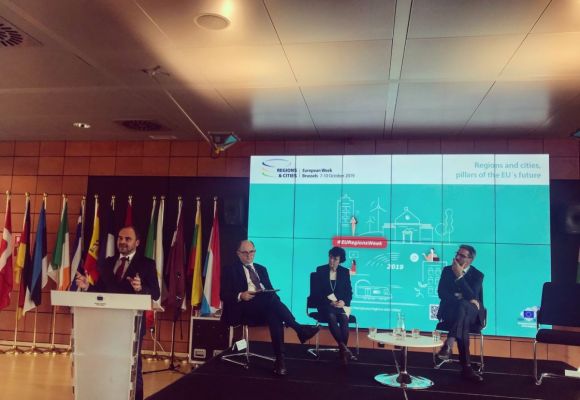
This Tuesday’s EU Region Week session on “Delivering disaster resilience at the local level” was about how cities and regions are increasingly taking action to reduce the risk of disasters. Also, about the adaptation to climate extremes, such as floods or storms. This is demonstrated by three regions’ specific interventions which may be seen as examples to follow. The presentations by Janet Edwards, Arno Kompatscher and Piots Calbecki show how digital tools, cross-border cooperation and systems for voluntary support can improve disaster resilience.
It soon becomes clear what all the speakers agree on: Climate change will inevitably lead to more natural disasters in the future. Local authorities are and will be asked for help first, as they are naturally closer to their citizens and should be able to act fastest. The invited speakers do not only share their opinions on why disaster resilience should be accelerated locally, but they also provide concrete examples of how this has been achieved in their home regions of Sweden, Poland and South Tyrol.
The panel at the Committee of the Regions starts with an introduction by Andrew Bower from the United Nations Office for Disaster Risk Reduction (UNDRR), who draws attention to the severe challenges at the local level : “where about 13 billion euro are lost every year due to climate extremes in the EU”. However, the cost of the damages does not only affect the economy, including infrastructure and agriculture, but also humans, in terms of life losses, injuries and health.
The Sendai Framework
For preventing new and emerging risks and reducing existing risks, the Sendai Framework for Disaster Risk Reduction was adopted by UN member states for the period of 2015-30. Although, according to the UNDRR, “the non-binding agreement recognizes that the State has the primary role to reduce disaster risk, that responsibility should be shared with other stakeholders including local government”. It is important to prepare and equip local authorities for disasters. Because when disasters hit, they need to be able to act fast, follow a strategy and rely on EU funds.
The number one target of the Sendai Framework is to reduce the global disaster mortality by 2030, and this concerns both manmade and natural disasters. However, the speakers merely focus on the latter.
Janet Edwards, Senior Advisor for Implementation of the Sendai Framework, explains that in Sweden, all cities are working according to the UNDDRs essentials. But there are 12 cities that are doing even more than required by law. She presents how three of those cities, namely Gothenburg, Karlstad and Malmö, tackle difficulties, particularly with floods. Disaster prevention on a local level in these cases includes sharing all information about risks online. For instance with risk maps, commitment to sustainable development and energy-conserving infrastructure design. Especially in Malmö, there are challenges due to surface flooding from extreme rain fall, so the goal is to channelize the water and create more green areas.
Climate change, a global problem
Other examples of how to deal with disasters locally are presented by Arno Kompatscher, governor of South Tyrol and member of the Committee of the Regions. He starts out by stating that “due to South Tyrol’s autonomous legislation, we are able to create our own laws to prevent main risks and do a lot when disasters happen”. Although climate change is a global problem, scientists predict that in the Alps there will be an increase of four degrees in the next 30 years, implying high risk for disasters such as rock- and mudslides or floods. The “Albina avalanche report” serves as an illustration of how cooperation can reduce disaster risk in a region. A platform created in collaboration of Tyrol, South Tyrol and Trentino informs people of risks in the whole region. For this platform first published in December 2018, weather report stations are working together to help prevent accidents.
Further, Piotr Calbecki, Marshall of the Kujawsko-Pomorskie Region in Poland, states how an exchange of experience and discussions are essential to become more resistant to disasters. Referring to a horrific storm that took place in summer 2017 in the region, he points out that the situation required the commitment of many, including volunteers. And this is another issue that should be worked on in many regions, as in order for people to be able to volunteer, there needs to be a system that facilitates them to, for instance, leave work in emergency interventions. To support victims and minimise future risks, Calbecki further states that “support should be strategically planned in short- and long-term, and we should raise awareness by cooperating with the UNDRR”. Last year, Poland became a participant in the Making Cities Resilient Campaign in Europe for the first time.
There is still a critical need
Apart from local authorities playing a key role in the prevention and reduction of disasters, Adam Banaszak, Alternate Member of the Committee for Regions, states that “if we ask EU citizens whether the EU should be involved if disaster hits, the answer is yes”. According to Banaszak, civil protection mechanisms and the solidarity fund are also important and the UN provides valuable networks and share best practices.
As has been said so often recently, climate change is the biggest challenge of our time. And with climate change comes - often unpredictable - disaster. Thus, it is crucial to be prepared, especially on the local level, where disasters hit and risks need to be reduced first and fast. This requires planning and working out strategies to prevent or handle them. Although much has been done, the session concludes that there is still a critical need for more local engagement and proactive responses to disaster.
Laura Naima Kabelka (Austria)



